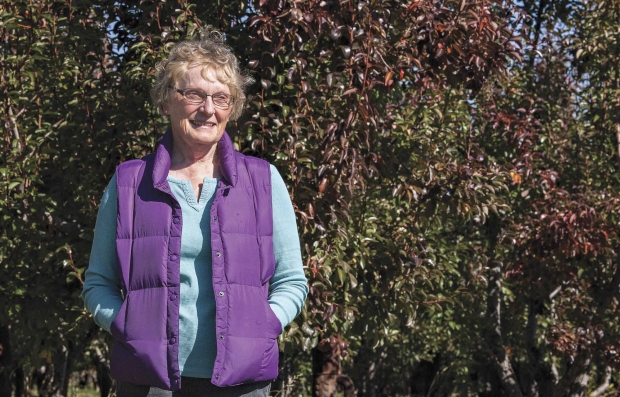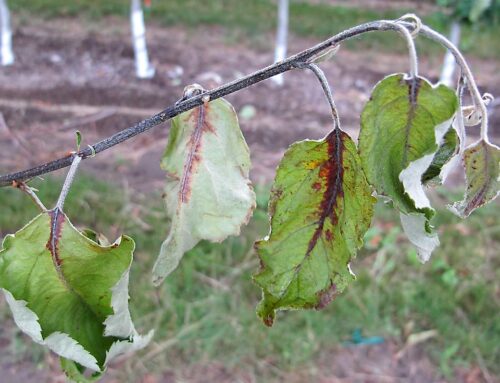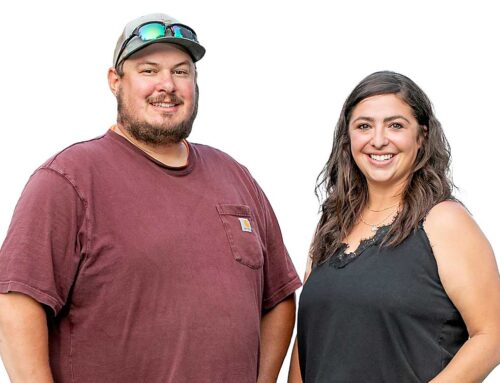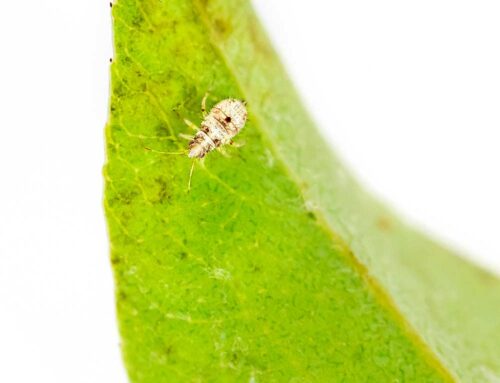
Nancy Vaughn in her orchard in 2013, credits her family and close relationship with Medford area growers and researchers for support following her husband’s death. (TJ Mullinax/Good Fruit Grower)
Ed and Nancy Vaughn did all the right things when they became new pear growers in the 1990s, researching what crop and cultivar to plant, networking with extension and other growers, and developing a market for their fruit. But there was one thing they didn’t plan for.
In 1993, the Vaughns moved to Medford, Oregon, to begin their “unretirement plan,” as Nancy describes it. Her grandfather had a farm in Medford that had been in the family since 1902. She and her husband decided it was time to do something with the 150 acres she inherited. Timing was right for a major lifestyle change—they had raised a family in Bend, Oregon, and Ed was retired from a career in forestry. So the couple began a new career in the tree fruit industry.
“We did a lot of research on crops planted in the Medford area and decided that pears were the thing to grow,” said Nancy. “We networked with Oregon State University researchers and other growers by attending local meetings, and we joined the Southern Oregon Sales packing cooperative as a way to learn from others and be part of a grower group.”
They planted 22 acres of pears in 1994, and began living full-time in Medford in 2000. They planted a handful of pear cultivars, including Bartlett, Packham’s Triumph, Bosc, Starkrimson, and Comice.
Ed developed a sales route in three counties, selling his fruit to local grocers in cities like Grant’s Pass, Medford, and Klamath Falls. Fruit for local sales were field packed and kept in cold storage rooms on the property, and some fruit was commercially packed and marketed through the cooperative.
Things were going well. But roles changed last year. Nancy became the farmer after her husband died in March following a short illness.
It takes a village
Good Fruit Grower visited Nancy in October, shortly after she completed her first growing season and harvest. She credited a village of people—OSU extension researchers Drs. David Sugar and Rick Hilton, local growers, field representatives, chemical company representatives, and her orchard foreman—for helping her to make crop decisions and get the fruit picked. “Everybody was so wonderful,” she said.
As a way to learn what she should be doing in the orchard last year, she regularly attended grower luncheon meetings, sponsored by OSU and held twice a month during the season.
“Growers freely shared information at these meetings, and they were really helpful to me, as was OSU Extension, who came out to my orchard,”she said.
What was the most difficult part of farming by herself?
“The hardest part was making those decisions about orchard treatments, pest control, weed management, and fertilizers. I had all of these people with expertise providing information, but ultimately, I had to make the final decision. At first I had buyer’s remorse when I made a decision to spray, but I finally learned that you just have to decide on something and go forward.”
Ed, who was meticulous in his planning and recordkeeping, left her with a detailed, 35-page procedural manual, a written handbook. “He knew he was old, so he wanted to have things like irrigation scheduling down on paper,” Nancy explained. “But he wasn’t expecting to get sick.”
One of the biggest challenges was knowing when to irrigate. “Even though Ed had tracked rainfall, ET
During frost season, Nancy’s sons from Bend came over to help run heaters, orchard fans, and undertree sprinklers. The two sons also helped keep equipment running during the season and pitched in at harvest.
Easy year
The 2013 season was a good year to be a Medford pear orchardist. Frost control was relatively easy, fruit quality was high, and the pears were large. The one negative was fireblight, and many orchardists, including Nancy, were busy cutting out shoot strikes after harvest in October.
“Everything this past season was easy, but it didn’t feel easy,” she said. “It was a good year for me to get started, but the bad thing was that it was a really good year for pears, so I really don’t know what I’m getting into.”
In her first solo year of farming, Nancy’s Comice pears were going to be included in the gift packs of Harry and David, proof of their high quality. Her fruit destined for Harry and David were packed by Naumes, Inc., of Medford, while other varieties went to Stadelman Fruit Company in Hood River, Oregon.
When the SOS grower cooperative packing house closed several years ago, the Vaughns’ fruit had to be shuffled about, with some going to Stadelman while their Comice stayed with local packers. The variety’s tender skin makes it difficult to ship long distances before it is packed.
Nancy is busy pruning and preparing the orchard for the coming season, although she said it’s too soon to decide about the long-term future. “We started the orchard with the intention of keeping the farm in the family for the next generation. So I’m going to try it for at least another season.” •






Leave A Comment